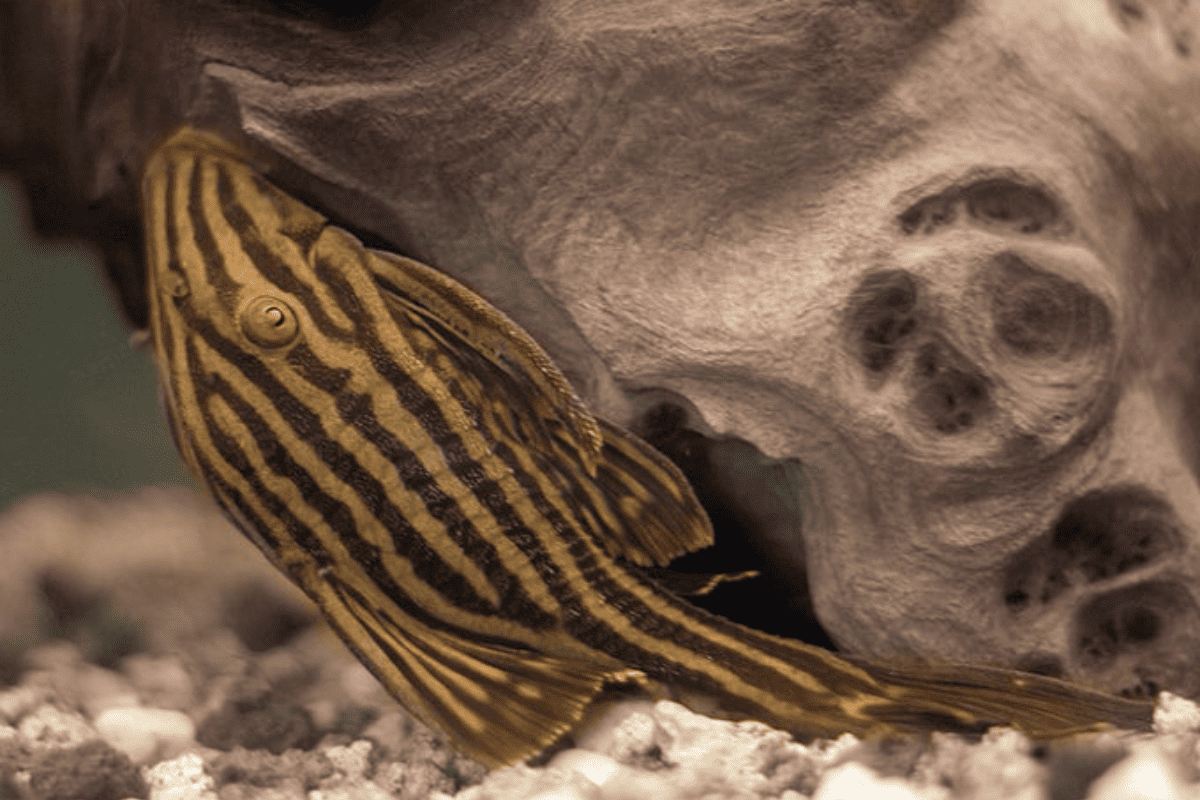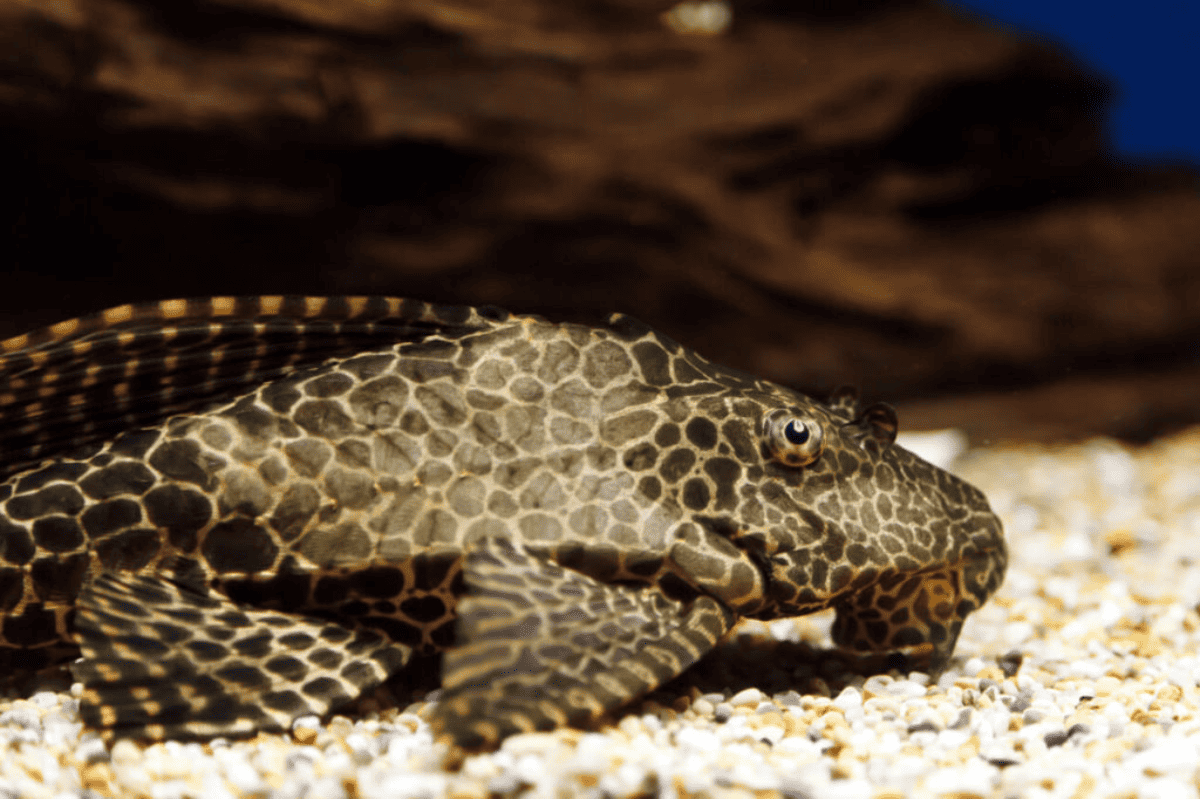Recently, I observed that my Pleco fish had become lethargic and was resting at the bottom. No matter how hard I tried, the fish didn’t move.
At first, I didn’t think much of it, but as the days went by, I became more worried about my fish’s health. This prompted me to delve deeper and look for answers.
In this article, I’ll explore the reasons why Pleco fish become inactive, how to tackle this issue, and the indicators that your Pleco might be stressed and in distress. Let’s dive in.

Is Not Moving in Plecos Normal?
No, it isn’t normal for Plecos to remain immobile for extended periods. If a Pleco is inactive for more than 24-48 hours, it’s considered abnormal and concerning.
- Natural Behavior: Plecos are nocturnal, but even during daytime, a slight shift or readjustment in position is expected; absolute stillness is unusual.
- High Activity Needs: A typical Pleco spends its day searching for algae on surfaces. Complete inactivity indicates a deviation from this natural scavenging habit.
- Adaptability: In new environments, Plecos might hide or be less active initially. But prolonged inactivity, even in a new tank, is a sign of distress or illness.
- Observation: Experienced aquarists often note that healthy Plecos, regardless of species, exhibit some movement when the aquarium light is turned off or dimmed.
Why Is My Pleco Not Moving?
There could be a couple of reasons behind a Pleco that has stopped moving altogether. Here’s what you should know:
1. Inadequate Water Parameters
Water quality plays a vital role in a Pleco’s health and behavior. Incorrect water conditions can cause stress or discomfort, leading to inactivity.
- pH Levels: Plecos prefer a pH level between 6.5 to 7.5. A significant deviation can affect their metabolic activities and result in lethargy.
- Temperature Fluctuations: Plecos thrive in water temperatures of 74-80°F (23-27°C). Sudden changes or extreme temperatures can negatively impact their behavior.
- Toxin Buildup: Ammonia, nitrite, or high nitrate levels are harmful. Regular water tests ensure these toxins don’t reach levels that can immobilize Plecos.

2. Sickness or Disease
Illness can make a Pleco less active. It’s essential to identify and treat any potential diseases early.
- External Parasites: If Plecos have white spots or seem itchy, they might have ich or another parasitic infection, leading to decreased movement.
- Internal Issues: Swollen abdomen or irregular excretion can indicate internal problems. Affected Plecos often show signs of fatigue or stillness.
- Fungal Infections: These manifest as white or cottony patches. Plecos with fungal infections may become lethargic and less responsive.
3. Lack of Proper Nutrition
A Pleco’s diet directly influences its energy and activity levels. Malnutrition can severely affect its behavior.
- Diverse Diet: While Plecos eat algae, they also need vegetables and specialized pellets. A one-sided diet can cause lethargy.
- Overfeeding Issues: Overfeeding can lead to digestive problems. Plecos may become inactive if they’re struggling with an overfull stomach.
- Nutritional Deficiencies: Lack of essential nutrients, vitamins, or minerals in their diet can result in reduced energy levels, making Plecos less active.

4. Old Age or Natural End of Life
Like all living creatures, Plecos also have a lifespan. As they approach the end of it, their energy and mobility naturally decrease.
- Lifespan Expectancy: Common Plecos can live up to 10-15 years in well-maintained tanks. As they near this age, it’s natural for them to be less active.
- Physical Changes: Older Plecos may exhibit faded colors, slower growth rates, and less aggression. Their reduced movement can be a sign of advancing age.
- Behavioral Changes: Just as elderly dogs or cats might slow down, older Plecos might spend more time resting or hiding, signaling their advanced age.
5. Stress or Trauma
Environmental factors, aggressive tank mates, or recent relocations can induce stress in Plecos, leading to decreased activity.
- Tank Transitions: Moving Plecos to a new tank or introducing new fish can be stressful. It’s common for them to hide or remain still until they acclimate.
- Aggressive Neighbors: If other fish are chasing or nipping at the Pleco, it may stay immobile to avoid drawing attention or due to the trauma.
- Sudden Disturbances: Loud noises, vibrations, or abrupt changes in lighting can spook Plecos. This might cause them to freeze or seek shelter, reducing their overall movement.
Also Read: Stress In Pleco Fish

How to Treat Plecos That Are Not Moving
Here are some effective methods for treating a Pleco that has been immobile for more than 48 hours:
1. Adjusting Water Parameters
A Pleco’s well-being is directly tied to water quality. Regularly adjusting these parameters can help revitalize a lethargic Pleco.
- Regular Testing: Use a comprehensive aquarium test kit. For instance, ensure pH stays between 6.5 to 7.5, and ammonia levels remain near zero.
- Water Changes: Perform 25-30% water changes weekly. Using dechlorinated water can prevent harmful chemical build-ups.
- Aeration: Equip the tank with air stones or bubblers. This increases oxygen, which Plecos rely on, especially in warmer temperatures. I found the Hygger Aquarium Air Stone (link to Amazon) to be extremely useful.
- Stable Temperature: Install a consistent aquarium heater. Maintaining temperatures between 74-80°F (23-27°C) is crucial for Pleco comfort.
Also Read: Do Plecos Need A Bubbler?
2. Diagnosing and Treating Sickness or Disease
When a Pleco shows signs of illness, swift diagnosis and treatment are essential for recovery.
- External Inspection: Look for physical changes like white spots, which might indicate ich, a common fish parasite.
- Quarantine: If sick, transfer the Pleco to a separate tank. This prevents potential disease spread and eases treatment.
- Consult Experts: If unsure about the illness, ask local aquarists or fish store experts for advice or potential treatments.
- Medication: Use treatments like anti-parasitic or anti-fungal solutions, following dosages accurately based on tank size. A good starting point would be the Seachem PolyGuard (link to Amazon).
Also Read: Pleco Fish Diseases
3. Ensuring a Balanced Diet
Proper nutrition can invigorate a lethargic Pleco, enhancing its vitality and overall health.
- Varied Diet: Offer Plecos a mix of algae wafers, blanched vegetables (like zucchini), and occasional protein treats like bloodworms.
- Monitor Feeding: Observe how much your Pleco eats. Remove uneaten food after 24 hours to prevent water contamination.
- Avoid Overfeeding: A thumb rule is to feed only what Plecos can consume in a few hours to prevent digestive issues.
- Supplements: Consider calcium or multivitamin supplements, especially if the diet lacks in specific nutrients vital for Pleco health. My recommendation: Seachem Nourish (link to Amazon).
Also Read: What Do Plecos Eat?
4. Providing Comfort for Aging Plecos
As Plecos age, they require more specific care and attention to ensure they remain comfortable and active.
- Adjust Tank Environment: Reduce water currents using baffles, as older Plecos may struggle against strong flows, preferring calmer waters.
- Safe Hiding Spots: Ensure plenty of caves or hiding places. Elder Plecos often prefer secluded spots, like driftwood arches, for rest. I personally chose the Dr. Moss Malaysian Driftwood (link to Amazon).
- Regular Observations: Monitor aging Plecos closely for signs of discomfort, adjusting tank conditions and dietary needs as they evolve.
- Gentle Tank Mates: Keep aggressive fish away. Opt for peaceful neighbors like tetras or guppies that won’t stress or harass aging Plecos.
Also Read: Pleco Fish Tank Mates
5. Minimizing Stress and Disturbances
Keeping a Pleco’s environment consistent and safe helps ensure they remain active and stress-free.
- Consistent Routine: Maintain a stable feeding and light schedule. For instance, use timers to keep lighting consistent, mimicking natural day-night cycles.
- Tank Placement: Position the aquarium in a low-traffic area. Avoiding loud noises or sudden movements around the tank reduces Pleco stress.
- Safe Introductions: When adding new tank mates, use the drip acclimation method. This eases newcomers in without causing abrupt changes.
- Protective Measures: Consider tank covers or mesh guards. These prevent Plecos from jumping out and keep external threats, like curious pets, at bay.

Are Some Pleco Species More Likely to Stay Still Than Others?
Yes, different Pleco species have varying activity levels and behaviors. While all Plecos have periods of rest, certain species are inherently more sedentary than others.
- Bristlenose Plecos: Known for their active nature, Bristlenose Plecos are often seen moving around, especially during the night, searching for food.
- Rubber Lip Plecos: These Plecos are more laid-back and often spend longer periods resting or attached to a particular spot in the tank.
- Royal Plecos: A larger species, Royal Plecos are less frequently on the move, often preferring to stake out territories and stay put.
- Zebra Plecos: Being smaller and more reclusive, Zebra Plecos are not as active as some other species, tending to hide during daylight hours.
Also Read: Why Is My Pleco Laying on Its Back?
What Environmental Factors Can Affect Pleco Activity?
Environmental conditions in the aquarium play a significant role in Pleco behavior. Adjusting these factors can influence their activity levels and overall well-being.
- Lighting Conditions: Plecos, being nocturnal, are more active in dimly lit or dark conditions. Bright lights during daytime might make them more reclusive.
- Water Currents: Strong currents can either encourage activity or stress Plecos. Species like Bristlenose might enjoy mild currents, while others prefer still waters.
- Tank Decor and Hiding Spots: Adequate hiding places, like caves or plants, influence Pleco comfort. An environment that feels safe can boost their activity.
- Tank Size and Space: Overcrowded tanks can stress Plecos. Ensuring ample space and territory can positively impact their movement and exploration.

Are There Seasonal Patterns to Pleco Movement and Activity?
Yes, like many aquatic species, Plecos can exhibit seasonal behaviors.
While kept in a controlled environment like an aquarium, they can still display patterns influenced by external seasonal changes.
- Winter Sluggishness: In cooler months, even with stable tank temperatures, Plecos may sense shorter daylight hours and become slightly less active, mirroring wild behaviors.
- Breeding Seasons: Certain Pleco species might become more active during specific times, often spring, when they’d naturally breed, exhibiting increased movement and territorial behaviors.
- Food Foraging: In the wild, food availability might change seasonally. In tanks, if diet mimics this seasonality, Plecos could show varied activity levels in response.
- Barometric Pressure Changes: Sudden weather changes, such as storms, can affect barometric pressure. Some aquarists believe Plecos might become more restless or agitated in response.
Also Read: Why Is My Pleco Not Eating?
Conclusions
For quick readers, here’s a short recap:
- Prolonged inactivity in Plecos, beyond 24-48 hours, is unusual and concerning.
- Several factors, like water parameters, disease, diet, age, and environmental stress, can lead to a Pleco’s immobility.
- Effective treatments include adjusting water quality, treating diseases promptly, ensuring a balanced diet, providing comfort for aging Plecos, and minimizing stress.
- Different Pleco species inherently have varied activity levels; for example, Bristlenose Plecos are more active, while Rubber Lip Plecos are more sedentary.
- Environmental conditions, such as lighting and water currents, as well as seasonal patterns, can influence Pleco behavior and activity.

